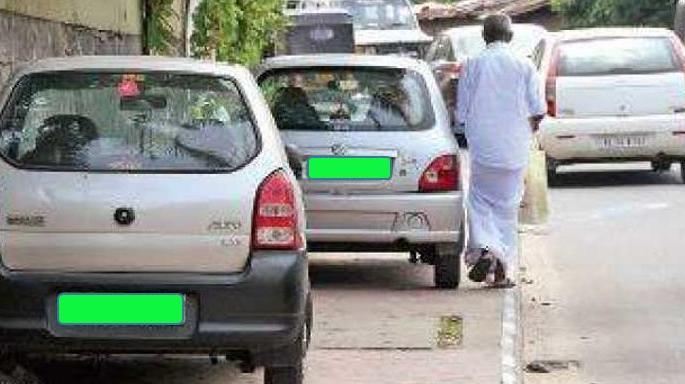News
Life of a pedestrian & the quality of walking infrastructure in India
Most roads in most cities have no dedicated sidewalks & people on foot have to share the same road space with motorcycles & cars.
BHPian karanddd recently shared this with other enthusiasts.
I saw this story in The Hindu and thought to share it here as there's been a lot of discussion around road safety, but most of it regarding vehicle occupants. Pedestrians (& two-wheeler users) are a far more vulnerable group. The reason is obvious. In the event of a collision with a rashly driven car, they stand almost no chance.
The article also points out in detail how poor the walking infrastructure is in India. Most roads in most cities have no dedicated sidewalks, and people on foot have to share the same road space with bikes and cars. This makes both the driving and the walking experience painful and unpleasant.
The article contains images of pedestrians forced to hop tall metal dividers to cross roads, which is an atrocious and hostile design. New roads that are constructed focus on making the flow of vehicle traffic smooth and altogether eliminate sidewalks, pedestrian crossings and traffic lights. Yet people nevertheless walk on and alongside them, as they have no other option.
It is unsustainable to build cities and roads that do not cater to pedestrians, as a majority of people must walk for life (& air quality) in any city to be plausible. If every person who needs to get around resorts to a motorised vehicle (even to get to and from public transportation hubs), the traffic gridlocks will become untenable and terrible (this is already happening in certain cities).
But walking cannot be encouraged until good walking infrastructure is in place. The way in which parents can let their children walk to school or the playground in European and Latin American cities must be replicated here. But in the current conditions, which parent will do that? This is why we see children being ferried to places in the 1-2km distance range by car or motorbike.
I want to ask fellow members what thoughts they have on prioritising walkability and how that can take place in India. Also, I want to ask what your walking experience is like in the city you live in. I personally try to walk wherever I can (in Delhi), but it's a horrible experience compared to walking in every other country I've been in.
In most places, there isn't a sidewalk so you cannot walk without constantly thinking about what's coming behind you (not to mention the terrible noise of incessant honking). Wherever there is a sidewalk, cars are parked diagonally in front of the sidewalk and in many places the sidewalk disappears or is broken for the driveway of a house, and sometimes cars are parked in the parts where it's broken. Or the sidewalk is blocked by a thela or tree or construction debris or the yellow police barriers. This forces you to jump off the sidewalk (because they are so high), walk past the parked cars and be on the same road as the cars. In most other countries, parked cars function as a barrier between walkers and motor traffic. Not in Delhi.
I truly believe that if our cities are made more walkable, it'll drastically improve our quality of life. There'll be less pollution and less noise. On top of that, it just feels good to walk around a city without being agitated and jittery and afraid of vehicles all the time. It'll make our cities feel less hot and less congested. I think all of that is worth it even at the cost of barring certain parts of our cities to all vehicles during the daytime (shops can resupply at night etc.), similar to the old town areas in European cities. What do you guys think?
Here's what BHPian Arsenic had to say about the matter:
Interestingly, India isn’t the only country with such horrid pedestrian infrastructure.
This YouTube shorts by Amsterdam-based Canadian YouTuber Not Just Bikes, who covers topics related to public transit and urban planning, shows just how odd and detached it feels to walk to a grocery store in the car-centric Canadian city of ‘Fake London’ (London, Ontario).
Here's what BHPian V.Narayan had to say about the matter:
Thank you for sharing this article and starting this most relevant of threads. I read a similar article in the Times of India in 1987. Clearly little has changed since then.
I wonder how many on team BHP have visited a DTP department of a municipality. DTP stands for Dept of Town Planning. One visit to the seniors there and you will know why our roads are so pedestrian-unfriendly - because the concept does not exist in their minds. In c.1999 as the head of the residents association of my colony (pronounced kalloni for those outside NCR), I had the opportunity of dealing with them. While they were courteous and willing to assist, their whole approach to pavements was 'isski zarrorat kya hai, sadak tou hai na V_____ji' - where is the need for a pavement when you have a road.
When an area is demarcated for town planning, often decades ahead of the actual construction inadequate allowance is made for the growth of population and vehicles. For example, the modern city of Gurgaon you see today had its broad layout, road widths and sector divisions planned for c1973-75 and frozen in the late 1970s with the detailed intra-sector layout, roads, sewage trunking design frozen by c1981. And even within that, I know at least for one sector (and must be for others) no allowance was made for pavements within a sector, though the typical NCR high jump pavements were catered for on the periphery of the sectors or along the main arteries. I won't blame them for not foreseeing the car and two-wheeler boom that came from the late-1980s onwards. But now with the motorized traffic pressure and a population 3X of what was planned for, the pavements get cannabalized by the road.
The story of good pavements starts from sensible town planning 50 years in advance.
Here's what BHPian ValarMorghulis had to say about the matter:
Ah, the plight of pedestrians.
It reminds me of an incident in Pune, 2018.
Hinjewadi Phase-2, Wipro Circle: Every evening a large crowd gathered there to catch their respective buses, cars etc. to go home while the traffic swelled with each passing second. Thanks to a paltry bus stand, the walking and standing crowd spilt over to the concrete (slightly elevated) pathway. But then the bikers had to cut through traffic!
So they did the best thing available to them: Drive on the pathway honking their way to traffic-free nirvana and nudging pedestrians and walkers alike. With the number of bikers abusing the pathway increasing, a few brave souls dared to oppose these bikes. Arguments ensued and honking increased exponentially. A few complaints were registered with the traffic police explaining how the meagre pedestrian area was abused by the bikers.
The police swooped into action. The next Monday, I came to the bus stand and lo and behold. The entire pathway was removed.
Here's what BHPian Lalvaz had to say about the matter:
Thank you for sharing such a comprehensive article. It was a very interesting read, and although it stated many obvious truths, the images and solid research really drove home the lack of safe mobility solutions for the pedestrians in our country.
I used to think that Delhi was much better than Bombay, which I feel is overly congested. I for one would not be very comfortable walking on many streets of Bombay due to the encroachments on footpaths, non-existent footpaths, bikers on footpaths, and the incessant honking by the other road users. While I love walking, and try to do 15k steps daily, I think it's wiser to restrict that to a treadmill or a walking track, not on our unruly roads.
I agree fully with you and the author of the article that we must make clean, safe footpaths available across our cities to ensure greater pedestrian traffic. We keep harping about the need to protect the environment, but often neglect the most eco-friendly mode of transportation, ie. Walking. High time we did something about it.
Check out BHPian comments for more insights and information.
























